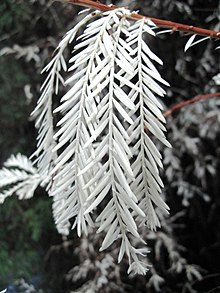Albino redwood

An 'albino'[a] redwood is a redwood tree which is unable to produce chlorophyll, and so has white needles instead of the normal green. It survives by obtaining sugar through the connections between its roots and those of neighboring normal redwood(s), usually the parent tree from whose base it has sprouted.[1][2][3] (Sap exchange through roots is a general phenomenon among redwoods.[4]) About 400 are known.[4] They can be found in both Henry Cowell Redwoods State Park and Humboldt Redwoods State Park, with eleven trees in the first.[4] However, the exact locations are not publicized to protect the rare trees.[5] They reach a maximum height of about 20 m (66 ft).[1] Other conifers lack the ability to graft their roots, so 'albino' mutants of other species do not survive to become sizable trees.[1]
The trees were important to Native Americans and were recorded in their legends. For example, the Pomo people used them in their cleansing ceremonies.[6]
Albino redwoods are generally regarded as parasites, but as of 2016 one researcher speculates that they are supported by other trees for their role in storing toxic heavy metals. Albinos apparently accumulate more metals than normal trees because of defective stomata, which cause them to lose more water through transpiration, forcing them to take up more water through their roots to compensate.[4]
Six phenotypes of albino redwood have been classified: white, bright yellow, cellular virescent green, pale green, mottled and nonchimeric variegated. Such mutants can be either basal (growing from a burl at the base of a tree) or aerial (branching off from a tree above the ground). The bright yellow form is exclusively aerial and is thought to be associated with excess xanthophyll production. The pale green form lacks just one specific type of chlorophyll and is almost always basal. Cellular virescent green trees have a few normal cells (whose abundance may vary over time) interspersed among the mutant cells.[7]
Ten cases are known of chimeric redwoods that have a mosaic of albino and normal tissues.[8] Only a single chimeric redwood is known to produce cones. Formerly threatened by the Sonoma-Marin Area Rail Transit rail development,[9] it has since been replanted.[10]
Three phenotypes of chimeric redwoods have been noted: sectorial, mericlinal and periclinal. In sectorial mutants, albino cells are present vertically through all cell layers, with genotype boundaries usually parallel to the stem. Mericlinal trees have mutant cells in only some cell layers and have an unstable phenotype; the albino cells can disappear and reappear in successive years. A periclinal chimera has both mutant and normal cells distributed horizontally across the tip of each bud propagating at equal rates, leading to a very stable phenotype.[11]
-
An 'albino' redwood in Humboldt Redwoods State Park, northern California
-
Another example in Humboldt Redwoods State Park
-
Albino foliage in the Santa Cruz Mountains, California
-
Example in the Santa Cruz Mountains
Notes
- ^ Albinism is defined in various ways; see Albinism in biology
References
- ^ a b c Stienstra, T. (11 October 2007). "It's no snow job - handful of redwoods are rare albinos". San Francisco Chronicle. Retrieved December 6, 2010.
- ^ Krieger, L. M. (2010-11-28). "Albino redwoods hold scientific mystery". San Jose Mercury News. Retrieved 2012-11-23.
- ^ "A Creepy Monster of the Forest: The Albino, Vampiric Redwood Tree". Discover Magazine Discoblog. Retrieved 2012-11-23.
{{cite magazine}}: Cite magazine requires|magazine=(help) - ^ a b c d Sarah Kaplan (October 7, 2016). "The mystery of the 'ghost trees' may be solved". Washington Post.
- ^ Science on the SPOT: Albino Redwoods, Ghosts of the Forest. YouTube video from Quest. KQED. August 26, 2010.
- ^ "Albino redwoods a winter treat". Humboldt County California's Redwood Coast. Humboldt County Convention & Visitors Bureau. Retrieved 2015-01-25.
- ^ Stapleton, T. (2015-01-18). "Mutation Types: Albino Redwoods". ChimeraRedwoods.com. Retrieved 2016-10-08.
- ^ Fimrite, P. (19 March 2014). "Cotati residents, scientists scramble to save albino redwood". San Francisco Chronicle. Retrieved 23 March 2014.
- ^ "California Arborist Fights to Save Tallest Albino Redwood Chimera Tree in Wine Country". NBC Bay Area. Mar 14, 2014. Retrieved 2015-01-25.
- ^ "Rare Chimeric Redwood Tree In Cotati Replanted After Being Moved From Railroad Tracks". CBS SF Bay Area. Aug 8, 2014. Retrieved 2015-02-15.
- ^ Stapleton, T. (2015-01-22). "Mutation Types: Chimeric Redwoods". ChimeraRedwoods.com. Retrieved 2016-10-08.
- Davis, D. F.; Holderman, D. F. (1 February 1980). The white redwoods: ghosts of the forest. Naturegraph Publishers. ISBN 978-0-87961-088-3.
External links
- Chimera Redwoods web site




